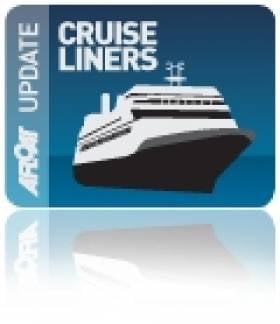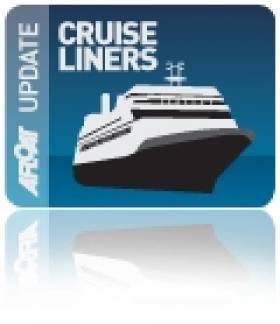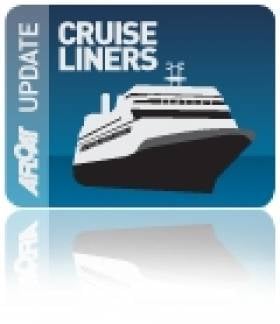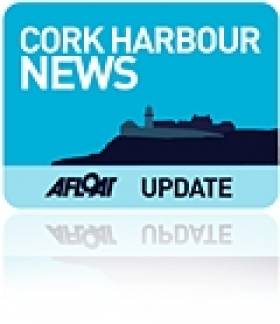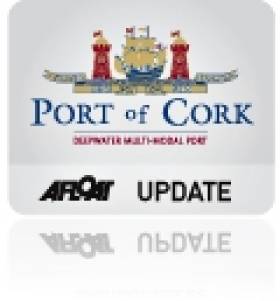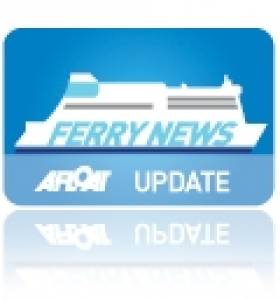Displaying items by tag: port of Cork
Queen’s Namesake to Retrace Royal Visit
The 90,901 gross registered tonnes cruise ship is to depart her Hampshire homeport, where she is to similarly follow the monarch in that she is scheduled to make a port of call to Dublin first on 9 September and make a call to Cork afterwards.
With a length of 295m / 965-feet the vessel will dock in the centre of the capital port before she sails overnight to make a morning arrival at Cobh, the dedicated cruise terminal for the Port of Cork. She is scheduled to stay at the Cork Harbour town formerly named Queenstown until a 17.00 hour departure.
Her visit coincides with Cork Harbour Open Day, where visitors can view the impressive vessel from the quayside, for more details visit www.corkharbour.ie
Incidentally her near-sister Queen Victoria also called to Dublin in May and the remaining vessel of the Cunard fleet, the 'flagship' liner Queen Mary 2 is also to dock in Cobh three days later after Queen Elisabeth's visit.
- Cobh
- Cork Harbour
- port of Cork
- Cruise Liners
- Cork Harbour Open Day
- Ports and Shipping
- Cobh Cruise Terminal
- Queen Elizabeth II
- Cork Harbour News
- Port of Cork Company
- Cunard Line
- queen victoria
- Port of Cork News
- Queen Elizabeth
- Queen Mary 2
- QM2
- Cruise Liner news
- TransAtlantic Liners
- Cruise ships
- Irish cruiseship calls
- Queen's visit to Ireland
- QV
- QE
- Cunarders
- Cobh Cunarders
- Cobh cruise calls
- Cunard liners
- Cunard cruiseships
- Royal visit to Ireland
- Cobh cruise liners list
Costa 'Del' Cork
To get a better understanding of the extensive facilities available on board for the 2,826 passengers, why not have a gawk using the Multi-Media Centre page by clicking HERE (noting when done then click 'Pictures and Movies'). From here you can enter the world of life-on board (with video presentations by scrolling down) for the aromatic thermal baths, the shops gallery, the Japanese tea room, Cinema Etoiles, the Samsara Spa or have a look of an ocean view category cabin.
Of the 1,130 cabins in total, 52 have direct access to the Samsara Spa, 662 with private balcony, 106 suites with private balcony and 4 suites also have direct access to the Samsara Spa. To read more about the ship which also features a thalassotherapy, treatment rooms, sauna, turkish bath and an UVA-ray solarium click HERE.
Three Masterpieces Set to Make an Impression in Dublin
Arcadia caters for the UK market and she is on a 13-night cruise which so far has included calls to North Shields, Tyneside, Invergordon, Shetland Isles, Glasgow, Belfast and Liverpool. After her call to the capital she heads for Cork and finally to St Peter Port, Guernsey.
Readers may note that the vessel is of the same design as of Cunard Line's Queen Victoria, which also called to Dublin in May and Cork. In fact Arcadia was to be given the regal name but the 2005 Italian built vessel was transferred from Cunard Line to P&O Cruises, which are under control of US-owned cruise giant Carnival Corporation.
Notable external features of the Arcadia are glass-fronted lifts, two pools, one with a skydome and an interior that is brimming with an art collection consisting of over 3,000 works. She has many facilities such as a three-tier palladium theatre, an intimate 30-seater cinema and gymnasium with an ocean view to inspire those exercising at sea. She was constructed in just twenty months by the Fincantieri shipyard, just outside Venice.
Likewise Eurodam has an extensive art collection theme that is based on the Dutch master's 'Golden Age' including "The Nightwatch, Two Minutes Later", a contemporary re-interpretation of Rembrandt's famous painting. In addition there are 17th-century watercolour maps by famed cartographer Johannes Vingboons.
Passengers on the 11-decked Signature-class can also enjoy the Pan-Asian restaurant and lounge surrounded by panoramic views, an explorer's lounge bar, an Italian restaurant adjacent to the lido, jewellery boutique, atrium bar, show lounge and a photographic and imaging-centre.
Last but not least to dock around lunchtime will be the 30,000 tonnes Ocean Princess, operated by Princess Cruises, another subsidiary of the Carnival Corporation. The 680-passenger / 181 m long vessel may be the smallest of tomorrow's callers and within the Princess Cruises fleet, but the former Tahitian Princess, which underwent an extensive dry-docking in Singapore last winter is well equipped with facilities.
She has a cabaret lounge, club restaurant and bar, casino bar, main pool and spa, steakhouse restaurant, panorama buffet, an Italian restaurant and the Tahitian Lounge. To see the work conducted at the dry-dock, you can view a slideshow by clicking HERE and to see the work in a completed state which also applied to her sister Pacific Princess, watch this VIDEO.
- Dublin Port
- port of Cork
- Dublin Bay News
- Princess Cruises
- P&O Cruises
- Cruiseships
- Port of Dublin
- Ports and Shipping News
- Cunard Line
- Dublin Port news
- Holland America Line
- queen victoria
- Fincantieri Shipyard
- Port of Dublin news
- Arcadia
- Eurodam
- Ocean Princess
- Irish cruiseship ports ofcall
- Dutch masters
- Rembrandt
- Onboard Art Collection
- Johannes Vingboons
Naval Salvage Tug Docks in Cork City
Built by Schichau Seebeck Werft, Bremerhaven, the 68m vessel has a limited armament capability and a crew of 45. Her main role is as a safety ship for use in submarine training and is equipped for fire-fighting, icebreaking and wreck location duties.
The veteran vessel had called to Dublin Port last weekend while her stay in the southern city will end with a departure scheduled for Monday morning.
‘Call for Events’- Cork Harbour Open Day
This year's Cork Harbour Open Day will take place on Saturday 10th September. The event aims to embrace the best of what Cork Harbour has to offer.
The Open Day seeks to raise awareness of the different free activities and events available for families in the harbour both on and off the water. If you would like to be involved in Cork Harbour Open Day or organise an event on the day, please contact Sara MacKeown Tel: (021) 4625375 or by email: [email protected]
All of the events will be promoted on the lead up to the day via PR, advertising and social media. For further information www.corkharbour.ie
Port of Cork Award Safehaven Marine New Pilot Boat Contract
The Port of Cork has today announced that local Cork Company, Safehaven Marine have been awarded the contract to build the Port of Cork's new pilot vessel. Due to be delivered in 2012, Safehaven Marine beat off strong competition from several other companies to win the contract.
Commenting on the contract Captain Paul O'Regan, Deputy Harbour Master, said: "As part of our planned renewal of equipment and vessels, the port recently advertised a contract to build a new Pilot vessel on e-tenders. We are pleased to announce that "Safehaven Marine", a Cork based boat builder has been successful."
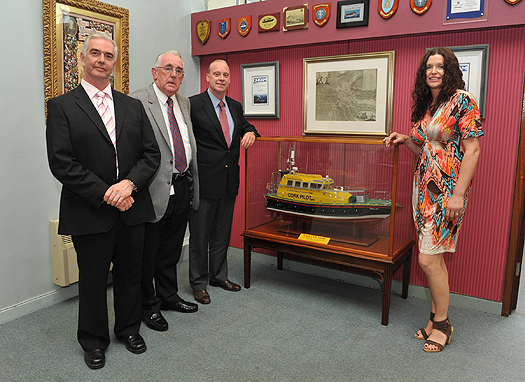
He continued: "Safehaven Marine pilot boats are highly regarded in the industry and have a reputation as very sound sea keeping vessels; this is in part, as a result of extensive design trials undertaken in large swells and rough seas around the entrance to Cork harbour, during winter storms."
Since building the last Cork pilot boat in 2006, Safehaven Marine has specialised in the 'niche' pilot boat market and continuously expanded. Currently employing 30 staff, Safehaven Marine operates out of two factories, one in Little Island and a new state of the art facility built in Youghal. They have supplied pilot boats worldwide, from Scandinavia, Europe, and the Mediterranean and as far afield as Asia and the Middle East, and in 2012 will pass a milestone by launching their 100th vessel since being established in 1996. Safehaven are now probably Europe's leading manufacturers of GRP pilot boat.
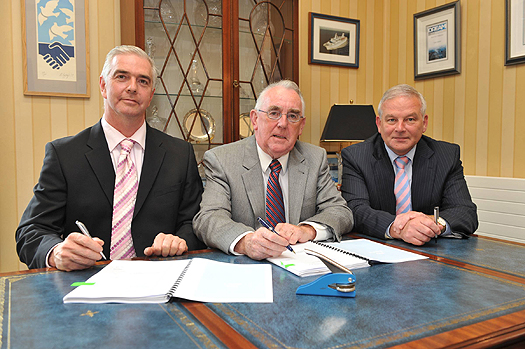
Safehaven Marine, Managing Director Frank Kowalski commented "This was a very special award for us as this is our local Port, and having built their last new pilot vessel six years ago, we have built up a great relationship with all the crew and pilots, and are delighted to be once again, six years later building their new pilot vessel. The Port of Cork's new pilot boat will be an example of our high level of design and engineering, and we all look forward to delivering their new pilot vessel in 2012".
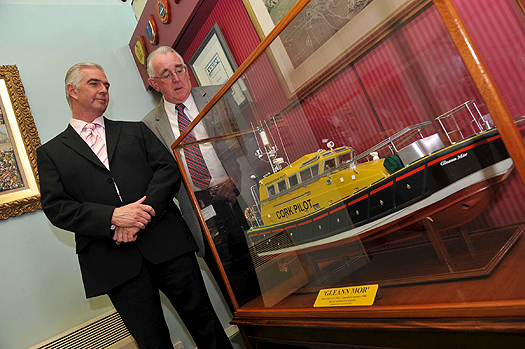
'Reasonable' Performance by Port of Cork in 2010
Turnover for the year amounted to €22 million (2009: €20.8 million) and operating profit before exceptional costs and interest amounted to €2 million (2009: €1.5 million). Profit on Ordinary Activities before taxation amounted to €2.2 million. In 2009 the Port of Cork successfully completed the Cork Dockers Rationalisation allowing the port to provide more efficient, reliable and most importantly cost effective shipping services for all users in the future.
Commenting on the 2010 annual results, Chairman Mr. Dermot O'Mahoney said: "Despite a reasonable increase of 5.6% in turnover, the Port of Cork has had to take a closer look at the company's current business practices, to ensure more efficient work practices and better control of costs. An increase in exports by 9.7% compared to 2009 show some areas are returning to growth and this is positive for the region."
Oil traffic which is mainly handled at Conoco Phillips Whitegate Oil refinery, increased by 3.56% to 5 million tonnes. Container traffic reduced by less than 1% to 147,526 TEU's, maintaining the Port of Cork's status as the second busiest Port in Ireland in terms of numbers of containers handled. Containers are shipped to and from Cork to Rotterdam, Antwerp, Zeebrugee, Scandinavia, North West Europe and the Mediterranean, highlighting Cork's role as a important gateway for trade.
Non-oil traffic accounted for 3.4 million tonnes in 2010, an increase in 486,806 tonnes or 16.7% compared to 2009.
The Port hosted 52 cruise liners in 2010 which brought over 100,000 passengers and crew to the Cork region and a welcome contribution to the local economy. The Port's continued investment in upgrading the Cobh Cruise Terminal has paid dividends by attracting some of the largest cruise lines to berth at the dedicated cruise facility. The Port of Cork is committed to the thriving cruise business, and aims to grow the business further from 54 calls to 75 calls over the next five years.
Brittany Ferries' Cork to Roscoff route had a very successful season operating from March to November. Overall the Port of Cork's Ro-Ro business was significantly boosted in 2010 by the resumption of the ferry service linking Cork with Swansea. The Port of Cork remains very supportive of the drive to maintain this ferry link which brings a welcome boost to the local and regional economy.
In 2010 the Port of Cork completed and published its Strategic Development Plan Review, a key element of which involved a comprehensive evaluation of potential sites in Cork Harbour for future port facilities. A detailed and comprehensive assessment was made of 13 sites in Cork Harbour for suitability to meet the needs of the Port in the short/medium/long term for different modes of trade. In preparing the Strategic Plan, the Company engaged in an extensive public consultation process with stakeholders. The issues raised were compiled into an Issues report which in turn fed into the review process of the plan. At the conclusion of the process it was determined that the primary location for Port activities should be in the lower harbour at Ringaskiddy. This location is already associated with considerable port related activity and development and is consistent with the relevant Development Plans of Cork County Council and the South West Regional Authority.
Chief Executive, Mr. Brendan Keating said: "Overall the Strategic Development Plan Review reiterates the Port of Cork's commitment to ensuring that Cork remains a world class Port with a sustainable and economically viable future in supporting and serving the economic competitiveness of the national and regional economy. The plan was prepared on the basis of planning for the long-term traffic projections of 2030 and beyond. However, in recognition that much can change in the intervening period the Plan sets out a framework which is flexible and adoptable in the short to medium term and on a phased basis."
With the completion of this Strategic Plan Review the Port of Cork is confident that viable new port facilities can be delivered in support of the business and trading needs of the region. The Port of Cork Company is convinced that the provision of Port infrastructure capacity is essential in enhancing the economic prospects of the State, Cork City, County and the South West Region.
Sustaining the quality of the environment in Cork Harbour, particularly in areas which have the potential to be affected or influenced by Port Operations, is a priority for the Company. The Port of Cork Company is committed to the highest standards in environmental management programmes through the implementation of global best practice and is accredited under ISO14001 and the EcoPorts foundation.
During 2010 the Company was involved in a number of local community based projects in Cork Harbour. The new Port of Cork City Marina was constructed during 2010, and it is an addition to the high quality facilities already in existence such as, the Millennium Garden in Tivoli, the Pier in Crosshaven and the landscaping at Ringaskiddy. The Port of Cork also continued to work in partnership with the National Maritime College of Ireland in providing training for Port and Harbour related activities. It is intended that this area of activity will be expanded over the next three years.
Additionally, the schools initiative, now in existence for over five years, continues to grow and be more successful in raising awareness levels of the Port among school children in Cork. The 2010 schools project, the most successful to date, recently concluded with a large number of projects submitted from schools. The theme of this year's competition was "Making Cork Harbour a Green Energy Hub for the future".
Ferry With 'Tourist Office' Celebrates 100,000th Passenger
In addition passengers travelling on the Julia can visit the newly installed tourist office where an advanced booking system will be available for all accommodation, leisure, and hospitality facilities located on both sides of the Irish Sea.
Irish and Welsh members of the West Cork Tourism Co–Operative, which established the ferry operation will staff the tourist office full-time during the summer months. The facility is unique to Irish-UK ferry services and was officially opened by the new Cork County Mayor Tim Lombard. For further information from the co-operative click www.westcork.ie and more about the other on board facilities click HERE.
With competition from summer sells on offer from rival operators on the Irish Sea, in particular on St. Georges Channel services, Fastnet Line are combating with deals to encourage higher occupancy sailings during the peak season.
The company are also preparing to accommodate Irish soccer fans in the autumn, following the success of Swansea City F.C. in gaining promotion to the Premiership.
- Cork Harbour
- port of Cork
- Fastnet Line
- M.V. Julia
- Ports and Shipping News
- CorkSwansea
- Cork Harbour News
- Julia
- Ferry news
- Swansea City F.C.
- Premiership
- Premiership League
- Irish soccer fans
- Swansea drydock
- WestCork Tourism CoOperative
- Cork County Mayor
- Cork County Mayor Tim Lombard
- Mayor Tim Lombard
- St. Georges Channel
- Irish Sea ferry news
Alliance Franҫcaise de Cork and Fondation Belém in association with the Port of Cork are pleased to announce arrival of the French tall-ship fleet, Belém, a 116-year old barque at one stage owned by the Guinness family, writes Jehan Ashmore.
During her four-day stay the pride of the French tall-ship fleet is to berth at Albert Quay, in the heart of Cork city-centre where the public can thread her timber decks on Saturday (2 July) between 11.30-17.00 hours and on Sunday (3 July) starting from 10.00 till 18.00 hours. There is an admission of €5 for adults, a concession of €3 and a family ticket costs €10.
Visitors can trace her long and varied career with an exhibit housed below decks of the historic vessel which was built in 1896 in Nantes. For nearly two decades she crossed the Atlantic transporting a diverse cargo but mostly spices, sugar and cocoa beans from her namesake port of Belém do Pará, on the north-east coast of Brazil bound for France. She would sail upriver on the River Seine to supply the cocoa beans for a Paris-based chocolate-maker.
Belem would later become under the British flag and she became the property of the Duke of Westminster, who converted her to a luxury pleasure yacht. In 1921 she was sold to the Hon. Arthur Ernest Guinness, who renamed her Fantôme II and took part in the Cowes regattas and cruised around the world between 1923 and 1924 with his family.
To read more on the vessel's other career's under several owners until her present-day role as a sail-training vessel operated by the Fondation Belém click HERE and also www.portofcork.ie
In addition to visitors boarding the Belem, the public are invited to attend free readings by the Cork poets William Wall and Thomas McCarthy. Accompanying the poets are French writers Maylis de Kerangal and Olivier Sebban for a session of Franco-Irish readings which too takes place on the Saturday evening between 18.00 -19.30 hours.
For further information contact Vytenė Laučytė, Cultural Coordinator, Alliance Franҫaise de Cork Tel: (021) 431 0677 or by email: [email protected]
All advance bookings for the visit on board the Belem are to be made at Alliance Franҫaise de Cork. Tickets are also available at the entrance to the tallship alongside Albert Quay, Cork. Last year Alliance Francaise celebrated its 50th anniversary
- Cork Harbour
- port of Cork
- Brazil
- Alliance Française
- Cork Harbour News
- Paris
- Belem
- Arthur Ernest Guinness
- Cocoa
- TallShips
- Albert Quay Cork
- Fondation Belem
- Tall Ships news
- Duke of Westminster
- Guinness
- Paris chocolate makers
- Fantome II
- William Wall
- Thomas McCarthy
- Cork poets
- French writers
- Maylis de Kerangal
- Olivier Sebban
The Empire Strikes Back
The 14,620 dwt US-based training-ship Empire State made a return call to the Port of Cork last night for a four-day stay, writes Jehan Ashmore.
At over 172m long the cruiser-sterned vessel with a port of registry of New York, moored at the Cobh Cruise Terminal which was recently visited by another US training ship, State of Maine (click HERE).
The veteran vessel now in her sixth decade of service and is the also the sixth training-ship to carry the name 'Empire State' for the State University of New York (SUNY) Maritime College.
Empire State was laid down as SS Oregon at the Newport News Shipbuilding and Drydock Company, Newport News, Virginia. She was launched in 1961 for the States Steamship Company and delivered a year later for service in the Pacific trades. For further information about the vessel's interim career before she was converted for her current role click HERE.
Despite her conversion she still presents a distinctive profile with the superstructure positioned amidships between the cargo-holds.
Prior to the Empire State's arrival the French cruiseship Le Diamant departed Cobh for an overnight passage to Dublin, where last year the Empire State made a port of call.
The next cruise-caller to Cobh is the 296-passenger Silver Cloud which is scheduled to dock on Monday evening.
- Dublin Port
- Cobh
- Cork Harbour
- port of Cork
- New York
- Silver Cloud
- Cobh Cruise Terminal
- Cruiseships
- Cork Harbour News
- State of Maine
- Port of Cork News
- Training Ship
- Empire State
- Suny Maritime College
- La Diamant
- Newport News and Shipbuilding
- Newport News
- States Steamship Company
- State University of New York




























